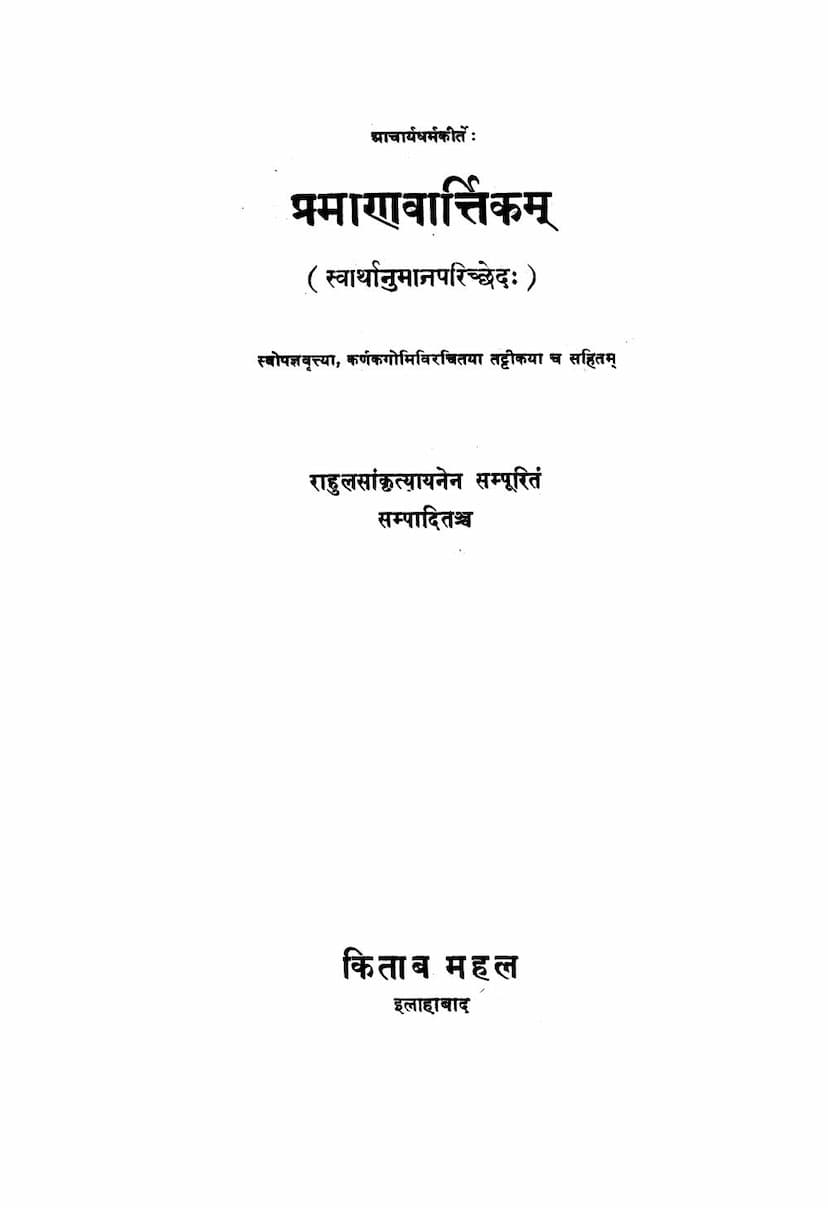Praman Varttikam
Added to library: September 2, 2025

Summary
The provided Jain text is titled "Praman Varttikam" by Rahul Sankrityayan, published by Kitab Mahal, Allahabad. The catalog link points to jainqq.org. The text is a commentary and compilation of the "Praman Varttikam" (Treatise on Valid Cognition) of the Buddhist philosopher Dharmakirti, with commentaries by Karnakagomin and Prajñākaragupta. Rahul Sankrityayan's contribution is as the compiler and editor.
Here's a summary of the provided pages (primarily focusing on the preface and introductory sections that outline the context and purpose):
Book Title: Praman Varttikam Author(s): Rahul Sankrityayan (Compiler/Editor), Acharya Dharmakirti (Original Author), Karnakagomin, Prajñākaragupta (Commentators) Publisher: Kitab Mahal, Allahabad
Overview and Context (from the Preface by Rahul Sankrityayan):
-
The Difficulty of Studying Ancient Indian Philosophy: Rahul Sankrityayan begins by lamenting the state of study of classical Indian philosophy, particularly Nyāya and Vaiśeșika, in the early 20th century. He describes the difficulty of finding competent teachers who could guide students through the complex works of masters like Vātsyāyana, Uddyotakara, Vācaspati, Praśastapāda, and Udayana.
-
The Creative Period of Indian Philosophy: He emphasizes that Indian philosophy was not a static outcome of a single mind or epoch. It evolved through the dynamic interplay of great thinkers, each building upon and negating earlier notions, contributing to a continuously growing stream of thought.
-
The Decline of Learning: Sankrityayan attributes the decline in the direct engagement with this "living stream" of thought to the destruction of great Buddhist centers of learning. This led to Buddhist scholars leaving India and a subsequent insularity and focus on scholastic quibbles ("Kupa-mandūkatā" - frog in a well mentality) in Indian philosophical discourse. Scholars became engrossed in wordplay rather than substantive philosophical inquiry, leading to a formal acknowledgment of ancestors but a practical ignorance of their heritage.
-
Rediscovery of Buddhist Masters: He highlights the importance of rediscovering the works of key Buddhist thinkers like Nāgārjuna, Vasubandhu, Dinnāga, and Dharmakīrti. He considers Dharmakīrti the culminating point of not just "dynamic" philosophy but of Indian philosophy as a whole, with his critical reasoning, bold analysis, and clear thinking being unparalleled.
-
The Significance of Pramāņavārtika: Dharmakīrti's "Pramāņavārtika" is presented as his chief treatise and a central work around which creative minds revolved. Sankrityayan notes that while Manorathanandin's word-by-word commentary on "Pramāņavārtika" exists, more elaborate works were needed to fully grasp its thought.
-
The Present Work's Contribution: The current publication aims to fill this gap by providing Dharmakīrti's "Pramāņavārtika" along with important commentaries. Specifically, it includes Karnakagomin's commentary on the first chapter (Svārthānumāna) and Prajñākaragupta's commentary on the remaining three chapters.
-
Karnakagomin's Commentary: Sankrityayan details Karnakagomin's commentary on the "Svārthānumāna" chapter. He notes that Karnakagomin was more exhaustive, quoting extensively from critics like Kumārila and Uddyotakara. Karnakagomin's work is largely dedicated to refuting static philosophical conceptions of "Sāmānya" (universals) and the authority of scriptures, indicating the book's primary purpose. He estimates Karnakagomin lived between 822 and 984 AD, likely in the 9th century.
-
The Editor's Efforts: Sankrityayan speaks about his own extensive efforts in restoring these texts, including translating "Pramāṇavārtika" from Tibetan into Sanskrit, a process that was challenging and involved multiple journeys to Tibet and Nepal. He expresses gratitude for the availability of manuscripts and the crucial help provided by various individuals and institutions, including Dr. K. P. Jayaswal, and the publisher Kitab Mahal for their rescue of the work from publication difficulties.
-
The Philosophical Currents: The preface also presents a chart illustrating the interconnectedness of major Indian philosophical schools (Mimāmsakas, Buddhists, Naiyāyikas, Jaina) and key figures within them, emphasizing the importance of understanding these intellectual rivalries and criticisms for comprehending the evolution of Indian thought.
Key Themes and Purpose:
- Revival of Classical Indian Philosophy: The publication of "Pramāṇavārtika" with these specific commentaries aims to revive and make accessible the profound philosophical insights of Dharmakīrti, considered a pinnacle of Indian thought.
- Understanding the Dynamic Stream of Thought: The editor stresses the need to view Indian philosophy not as isolated "ponds" but as a "mighty river" flowing dynamically through conflicts and agreements between thinkers.
- Critique of Scholasticism: The text implicitly and explicitly critiques the stagnant and word-focused approach that had taken hold in some Indian philosophical traditions, advocating for a return to the creative and critical spirit of the masters.
- Interconnectedness of Schools: The emphasis on the interaction between Buddhist, Brahmanic, and Jaina schools highlights the holistic nature of the philosophical landscape.
- The Role of Pramāṇa (Valid Cognition): As the title suggests, the work likely delves deeply into the theory of knowledge, the criteria for valid perception and inference, and the nature of reality as understood through these means, particularly from Dharmakīrti's sophisticated Buddhist perspective.
The provided pages focus heavily on establishing the historical and intellectual context for Dharmakīrti's "Pramāņavārtika" and the significance of the specific commentaries being published. It sets the stage for a deep dive into the philosophical arguments within the "Pramāṇavārtika" itself, likely focusing on epistemology and metaphysics.